I’m cheating. Even though yesterday wasn’t an official workshop day (a few of our group were still arriving), I spent a couple of hours yesterday in the Hotel Colon’s excellent conference facilities doing some photographic teaching with the majority of the students. Since I’ve only got a couple more students to get caught up today, I’ll do that on the plane, the bus, the panga, and every chance I get until everyone’s up to speed.
Because I teach some very particular aspects in my approach to photography and use a very specific vocabulary, I need to get everyone bought in and on the same page. No, I’m not going to recap the specific things I teach; come to a workshop if you’re curious ;~). But as you’ll see, we won’t have much time before we hit a very target rich spot, so basically I have only today to get some of my teaching into everyone’s head before the fireworks begin.
This morning we checked out of the hotel and went to the airport for our late morning flight to San Cristobal, where our boat sails from.
It might surprise you that there are now multiple airlines flying to and from the airlines, most notably TAME (the Equadorian military-started airline), and AeroGal (a subsidiary of Avianca). The very first time I went to the islands, there was basically one flight a day. These days there are multiples, and serving two airports (Baltra and San Cristobal). With tourism supposedly* at about 160,000 visitors a year, that implies a need for almost 500 seats a day to the islands, but it’s also common for many of the locals to fly back and forth to the mainland, too. For example, one of naturalists was on the flight with most of the group.
*Why did I write “supposedly”? Because 160k visitors at 16 visitors a group means you need 10,000 group weeks to hit that number. But in terms of boats there are about enough to absorb 100 groups a week, and with 52 weeks in a year that implies a max of about 83,000 visitors using the boats. So either Ecuador is counting Ecuadorians visiting the four cities in the islands, or the number is wrong (or both ;~).
The hour-and-a-half flight is being flown these days mostly by Airbus 319s and 320s (AeroGal), and some older 737s.
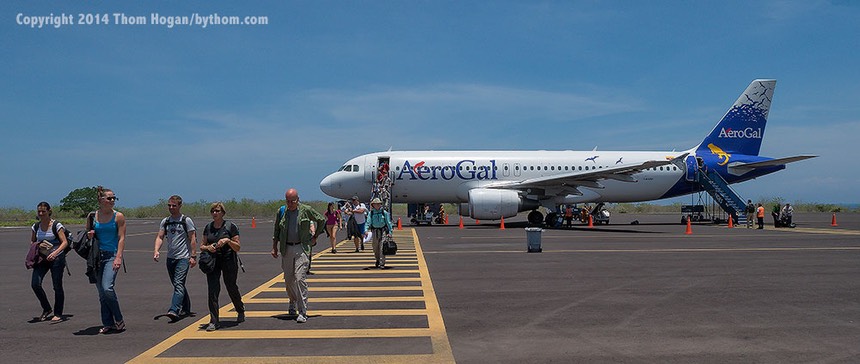
Arrival at the San Cristobal airport
The airports on the islands are going through some transition. The new terminal at Baltra has apparently been built since I was there two years ago, and the one on San Cristobal is in progress. The process of landing used to be total chaos, now it’s just near chaos. It used to be that you paid your park fees when you got to the island, and it was worse than customs in some countries with all the people waiting in line, especially when multiple planes landed simultaneously.
Today—at least for San Cristobal—the park fee and forms required are being paid and filled out in advance, so it’s mostly just a line to present them, get them stamped (and your passport stamped with a tortoise if you’d like) and hand you back your exit and souvenir card (don’t lose the exit card; when you leave it’ll cost you US$10 and some extra effort if you do). So things move a lot faster than they used to.
Still, with an Airbus full of folk needing to perform the entry process, there will be a line, and it will take a few minutes to get through this process. Upon exit, you’ll be met by a representative(s) for your boat. No need to claim baggage in San Cristobal, they’ve figured out how to match luggage up to boats and just bring those directly to the boat.
Since I was sitting up front in the plane, as was one of our naturalists, it was just a matter of minutes before I was off the plane and out of the terminal waiting for the rest of our group and introducing them to our two naturalists. Unfortunately, two of our group were amongst the last to get off, so we had to wait one full plane-load to get our group back to together. That said, it’s a far more pleasant process today, faster, and you don’t tend to have situations like what I once encountered, where I was standing outside in the mid-day heat for over an hour waiting to even get to the park entrance procedure.
With the group together, we boarded a bus and made the five-minute drive to the public dock. And that’s when you could begin to tell we were a group of photographers. Sea lions were on the dock, around the dock, near the dock, in the water next to the dock, and everything stopped as shutters started getting clicked. It’s always good to get that first wildlife encounter out of the way quickly.
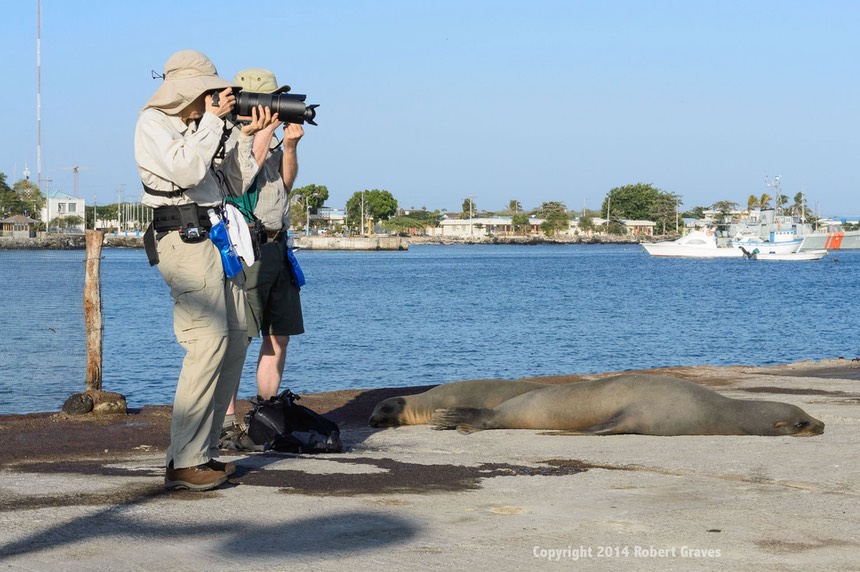

The panga traffic jam at the docks. This is just for our boat and our two sister boats. Four other boats were loading passengers, too.
Into the pangas (Zodiacs in our boat’s case) and off to our ship for lunch, some preliminary orientation, and of, course, the required fire drill muster and safety test (must be done within 24 hours of embarking, but it makes sense to do it immediately so that people know exactly what they should do in emergencies).
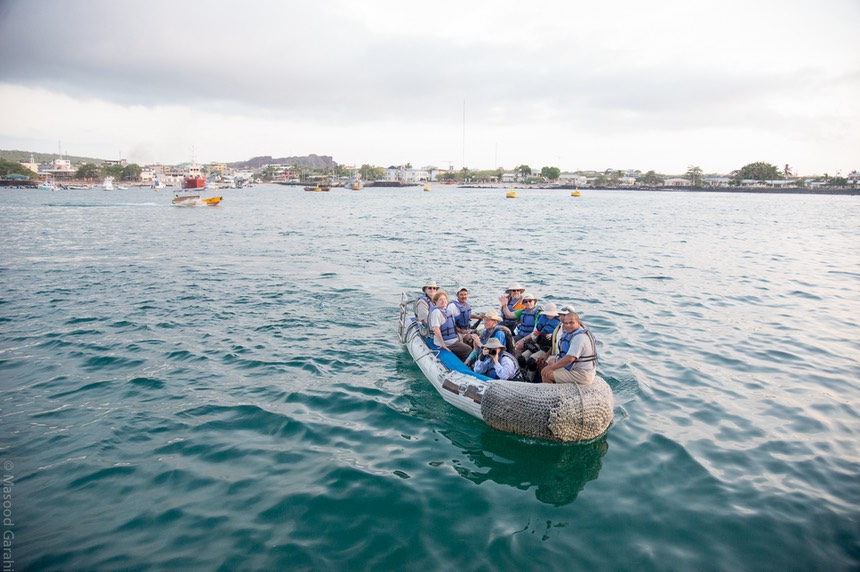

As we made our way on panga to our vessel, we passed my old boat, the M/V byThom. As you can see, you don’t want to leave your boat unattended for any length of time. The animals have a way of taking back territory if you let them.
After a nice buffet lunch, we gave everyone a few minutes to do some unpacking, then at 4pm, we were back in the pangas to the dock, loaded up a bus and went for a half-hour drive up to a volcanic cone filled with a lake at El Junco. The attraction here was frigate birds, though some got caught in photographing other birds:
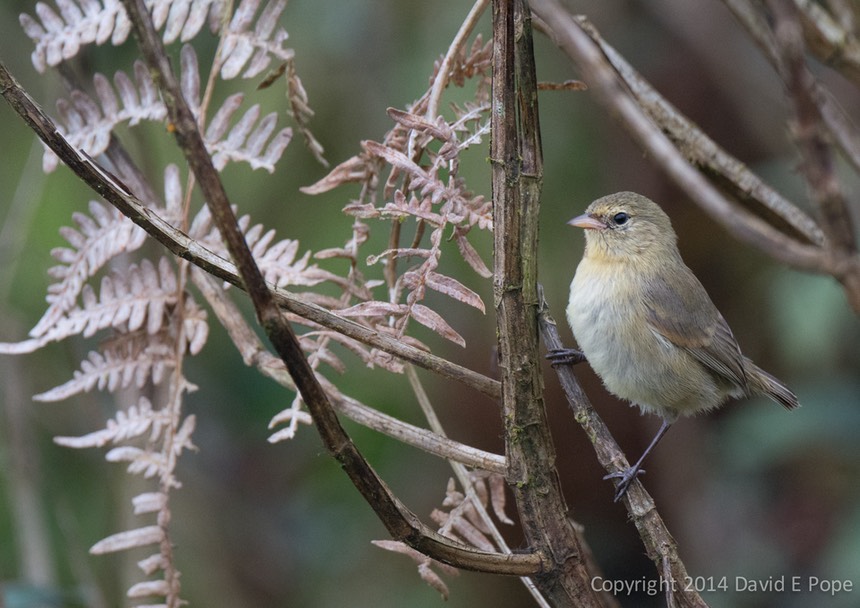
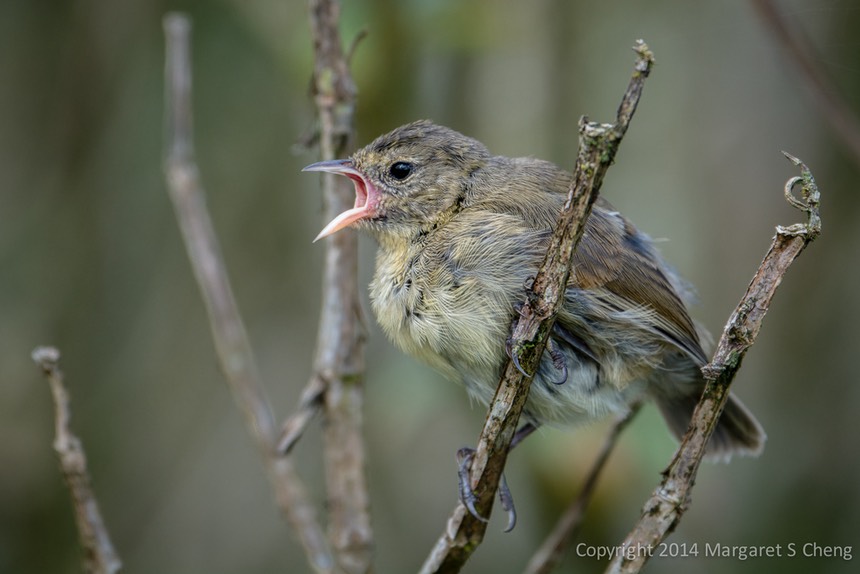

Wait, I was writing about frigate birds, I think.
The interesting thing about frigate birds is that they are aquaphobic. Unlike many sea birds, they don’t actually dive into the ocean to catch fish. They like to steal from others who’ve done the dirty work ;~). Indeed, frigate birds are a strange bunch: they only nest in bushes or trees, and the only other thing they do is fly plus at this time of year, mate and raise young. They don’t like water because they don’t have the lanolin and other protection on their feathers that many birds do (e.g. the Boobies). They aren’t exactly equipped with long legs like some birds, and the terrain means that if they get to the ground, they often will have a difficult time getting back into the air. I’ve encountered grounded frigate birds that ended up in some dense bushes and had no way to get back into the air without having to pick their way through the bushes on their awkward legs.
Still, all animals need fresh water, and they need to stay clean. And here at our first site, we got to watch frigate birds drop down into the fresh water of collapsed cone (briefly) and get what they needed, and in a few cases, get some much needed cleansing. I watched one young bird get a little too wet, and he then struggled to keep flying after that.
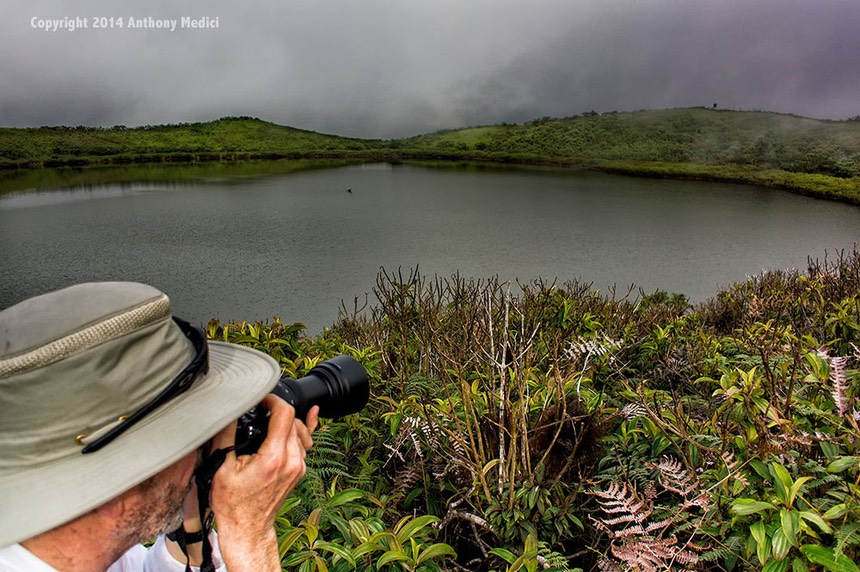
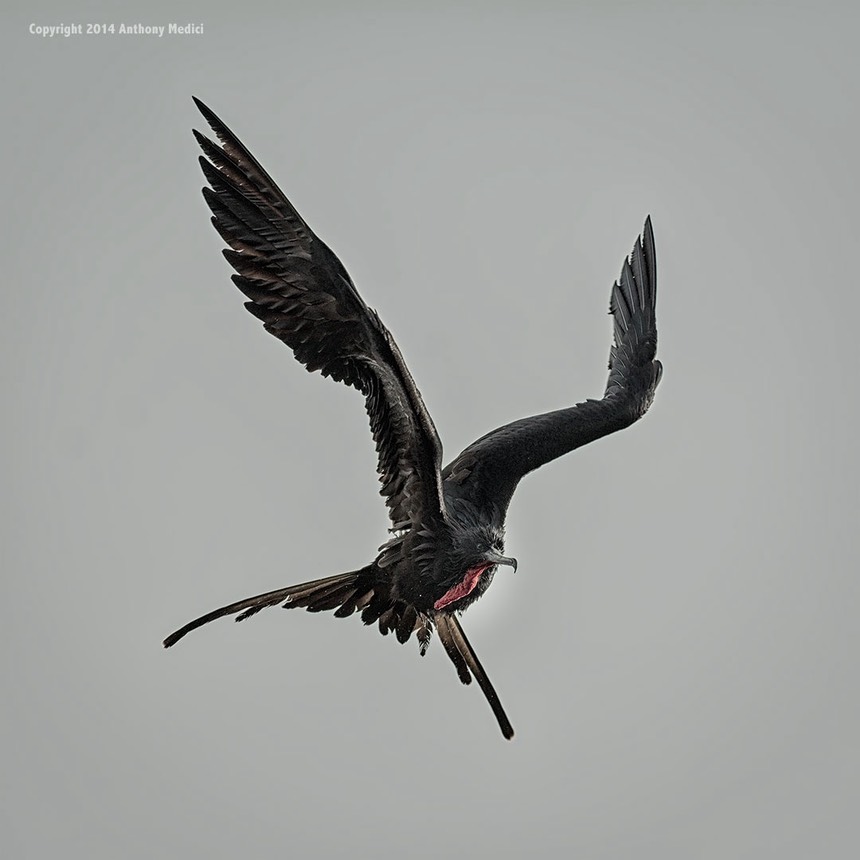
You’ll see frigate birds barely touch water (with their beaks) most of the time. With sea water, they’d only be doing that if they thought there was something they could scoop from the water, such as a fish dropped by another bird. But when they get wet, they start to look a bit disheveled in flight:
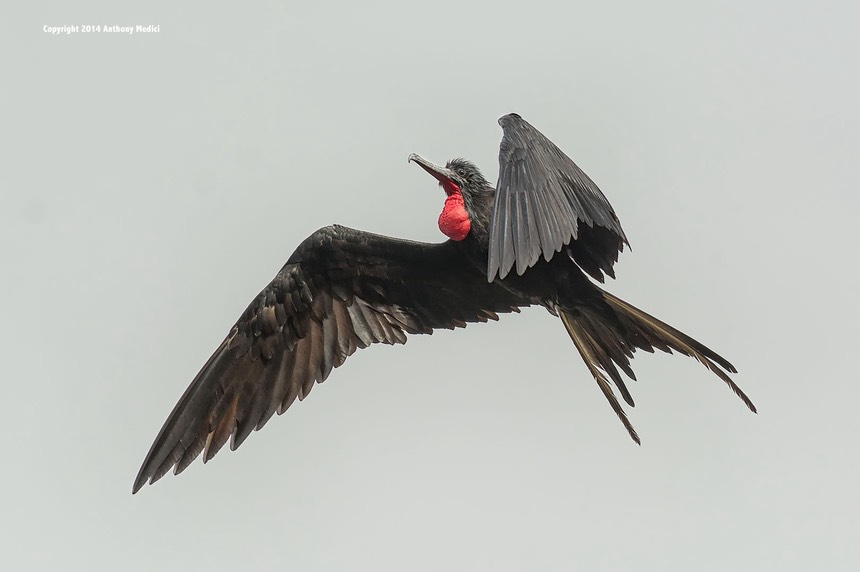
Normally, they look much more trim and graceful:
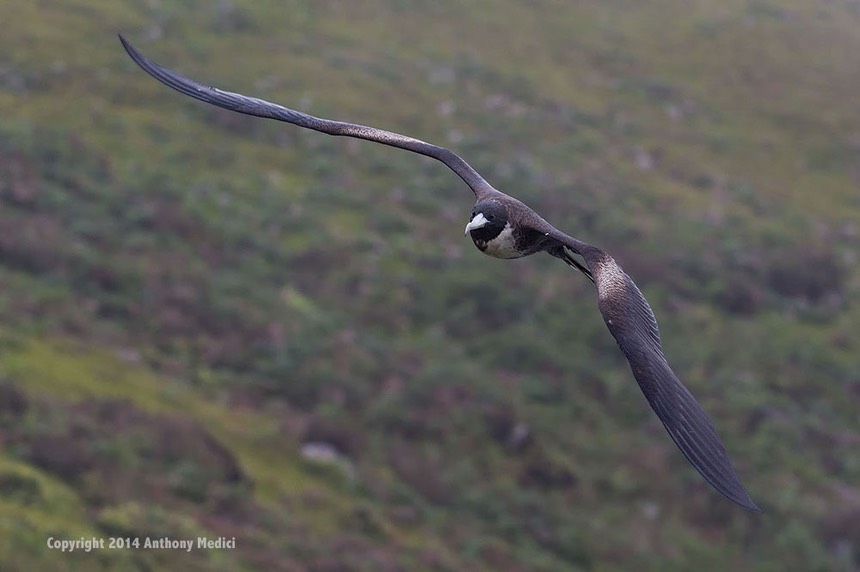
Since this was our first attempts at birds in flight on the trip, and because the conditions weren’t exactly conducive to great shooting, all of us—including me—went through a bit of trial and error and practice this afternoon. That’s sort of as planned. Tomorrow we have one of the best bird sites in the islands to visit, so getting everyone used to what they need to do to get the shots they want was a useful afternoon’s work.
Now for the bizarre side of Thom: I never pass up signs, especially odd or unusual or curiously placed ones. I have this fetish about them: I have to figure out how to use the sign in some visual pun or message of some sort.
Halfway down the trail to the shore edge, which wasn’t all that photographic, we came upon the following sign. Yes, that’s me on the left talking with Drew about what we might do with it, and someone else’s picture of us trying to come up with a picture. Yeah, that’ll work ;~). Foreshadowing: you’re going to see more signs in this blog.

We didn’t have a lot of time with the birds at the lake, as it loses light early and the highland mists also conspired against us. We also have a very long cruise to deal with this evening, and thus need to get away from Puerto Moreno as soon as possible. Indeed, no sooner did we get back on the boat just after sunset, the Captain raised anchor and we were off.
Not a lot of images to write about today, but that will change dramatically tomorrow, our first full day in the Galapagos.
Landings: the docks at Puerto Moreno provide a dry landing, though often you’ll be picking your way through sea lions
Snorkeling: generally no snorkeling on arrival days, as by the time you’ve settled down in the boat you really only have time for one activity
Major New Sightings: sea lion, frigate bird
